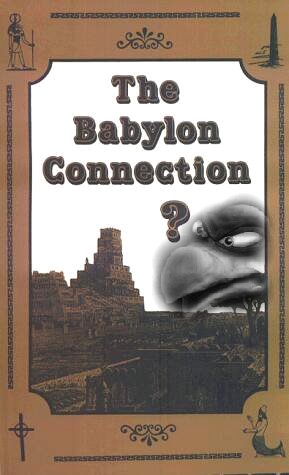The Two Babylons
Expanded Edition - 2003by
Alexander HislopJune 27 1833 - February 16 1892
Greenock, Scotland
Discover how a religion started by Nimrod and his wife, Semiramus, in Babel, spread throughout various regions of the world, and taking on different names under different pagan religions, but keeping the same pagan rituals and trappings.
These same occultic rituals embody the Roman Catholic Church of today.
Learn the true origins of: The Mother/Son worship, the sun god, The occultic Mass, The Wafer god (Eucharist), the Purgatory myth, The Sovereign Pontiff, Prayers for the Dead (necromancy)Rosary magic, The Sign of the Cross, The Confessional, Occultic clothing and Crowning of Images, Priests, Monks, and Nuns, Relic Worship, Worship of the Sacred Heart, Extreme Unction, the White Magic of Romanism, and much much more!
Table of Contents
Chapter I The Two Religious Systems
Distinctive Character of the Two Systems
Chapter II The Objects of Worship
Section I. Unity Under False Trinity
Section II. The Mother and Child Worship
Sub-Section I. The Child in Assyria
Sub-Section II. The Child in Egypt
Sub-Section III. The Child in Greece
Sub-Seciton IV. The Death of the Child
Sub-Section V. The Deification of the Child
Section III. The Mother of the Child
Chapter III - Rituals and Festivals
Section I. Christmas and Lady-day
Section III. The Nativity of Saint John
Section IV. The Feast of the Assumption
Chapter IV Doctrines and Disciplines
Section I. Baptismal Regeneration
Section II. Justification by Works
Section III. The Sacrifice of the Mass
Section V. Purgatory and Prayers for the Dead
Chapter V Rites and Ceremonies
Section III. The Clothing and Crowning of Images
Section IV. The Rosary and Worship of The Sacred Heart
Section V. Use of Lamps and Wax-Candles
Section VI. The Sign of the Cross Origin
Chapter VI Religious Orders
Section I. The Sovereign Pontiff
Section II. Priests, Monks, and Nuns
Chapter VII Historically and Prophetically Considered
Section I. The Great Red Dragon
Section II. The Beast from the Sea
Section III. The Beast from the Earth
Section IV. The Image of the Beast
4. Sola Scriptura - Faith in the Scriptures Alone
Terminology and Definitions:
(A - B) (C - H) (I - K) (L - Q) (R - T) (U - Z)
Ralph Woodrow's Babylon Connection
The majority of Woodrow’s Bibliography in The Babylon-Connection? is from catholic apologists, catholic encyclopedias, and Seventh Day Adventists
Woodrow just takes his old chapters from His first book;
Babylon- Mystery Religion, and now says Hislop’s claims are just happenstance, a similarity, a coincidence.
That is the theme throughout every chapter: “oh this is just coincidence; these examples just look the same, “Please look the other way – emphasis mine”
Woodrow knocks on Hislops’ style of using phrases like, “everyone knows, and this is well known” but Woodrow wasn’t living in Hislops’ time and doesn’t know what they knew at that time.
Woodrow compares Hislop’s examples with other cultures of the world and says “See, these cultures practice this and they are not catholic, but Woodrow fails to realize, or admit, that the whole discovery behind Babylon is that it spread throughout all cultures.
Any other examples than the ones I cite below are just redundant proofs of Woodrow’s premise:
Pp 6-13 Woodrow does not use any sources to claim that since so many names are used for Nimrod and Semiramis they cannot be the same people (of course it is hard locating someone 4000 yrs. old and multiple names is a common practice in Ancient mythologies)
Pp 15-16 Woodrow claims that since it is so hard to go back in research of Nimrod and so many names are involved then it cannot be proven. (But that does not disprove it either
p. 19 Woodrow claims since there are many instances of nimrod and Semiramis with different names they must be all myth
P 27 Woodrow claims since there are many fables of Nimrod (which is true) then all stories of Nimrod are untrue
p. 30 Woodrow claims modern obelisks can certainly not be a symbol of worship because no one recognizes them as such anymore, (but Hislop was referring to it’s origin). Today obelisks may be quite meaningless but that does not mean it was always insignificant or will not be used in worship in the future One World religion.
pp.34-36 Woodrow does claim Catholics place too much devotion upon Mary but since they don’t believe in Semiramis and Semi does not act like Mary then they must not have adopted her rituals
Pp 38-41 Woodrow disregards the spread of Tammuz worship as coincidence of Ezekiel 8
p. 43 Woodrow uses Catholic sources to disprove Hislop and uses his ‘similarities’ song and dance to excuse the ritual rites of sainthood. (No such thing as catholic saints, all born again believers are true saints according to the Word of God)
Pp. 59-60 Woodrow excuses the pagan mark of Tammuz and claims God asked for the same mark to be placed upon foreheads but the scriptures do not reveal what that mark was.
P 64 The coincidence of the Sun shapes in Catholicism are just ‘similarities’ please ignore.
pp. 82-83 Woodrow explains he researched articles on Bacchus but never suggests which articles he used so we can compare them.
p.85 Woodrow claims relics are not pagan and it is ok to keep relics.
p. 88 Woodrow says he looked up a Hislop’s references and couldn’t find Hislop’s claim but Woodrow never reveals what references He was looking up.
p.108 Woodrow purports these pagan origins just happen to be ‘similarities’ so it must be ok for Catholics to do the same thing.
Woodrow gets confused with the mythology of Nimrod and the actual beliefs and practices of pagan religions.
I do not hold Hislop's The Two Babylons as infallible, but I do see the similarities of the Babylonian rituals practiced in Roman Catholicism.
More Hanky Panky
Hank Hanegraaff displays a gross ignorance both of the character of Roman Catholicism and of church history. For more than a thousand years, Bible-believing Christians have identified Rome with the Harlot of Revelation 17. To give an overview of this issue, we offer quotes from the writings of two men who wrote widely acclaimed church histories. Both men knew far more about Roman Catholicism than Hank Hanegraaff. One is Peter Allix, who published a diligently researched history of the Waldenses in 1692. The other is John Dowling, who published the classic "History of Romanism" in 1847. Only seven years after its first publication, it could be said of Dowling’s book, "it has already obtained a circulation much more extensive than any other large volume ever published in America, upon the subject of which it treats; or perhaps in England, with the exception of Fox’s Book of Martyrs." Note what these men said about the identification of Rome with the antichrist and the Harlot of Revelation:
Allix says: "Now it is certain, first, that since the tenth century, wherein Arnulphus, Bishop of Orleans, called the Pope Antichrist, in a full Council at Rheims, nothing has been more ordinary than to give him this title. The Antipopes of the eleventh century very lavishly bestowed it upon one another. This example was followed in the twelfth century, and has never since been discontinued till the time of the Reformation; a vast number of writers having set themselves against the Pope and the Papacy, openly proclaiming him to be the Antichrist, and his Church the Great Whore, and Mystical Babylon" (Peter Allix, The Ecclesiastical History of the Ancient Churches of Piedmont and of the Albigenses, I, 1692, 1821 edition, p. 281).
Dowling says: "The result of our examination is the solemn conviction . . . that the Romish, so far from being the true church, is the bitterest foe of all true churches of Christ--that she possesses no claim to be called a Christian church--but, with the long line of corrupt and wicked men who have worn her triple crown, that she is ANTI-CHRIST. . . This identity of papal Rome with anti-Christ was maintained by Luther, Melancthon, Calvin, and all the continental reformers; by Latimer, Melancthon, Calvin, and all the British reformers: by the illustrious Sir Issac Newton, Mede, Whiston, Bishop Newton, Lowth, Daubuz, Jurieu, Vitringa, Bedell, and a host of equally pious, illustrious and learned names. The same testimony has been borne in the authorized doctrinal standards of the Episcopal, Presbyteiran, Lutheran, Methodist, Baptist, and other churches both of Europe and America. The same doctrine is still taught in the theological school of Geneva by the illustrious D’Aubigne and Gaussen, and with but here and there a solitary exception, by all the most learned professors and clergymen of the present day, connected with the various evangelical denominations of protestant Christians" (John Dowling, The History of Romanism, 2nd edition, 1852, pp. 646,47).
Hank Hanegraaff is obviously at liberty to disagree with the countless numbers of godly Christians who have identified Rome with the Harlot of Revelation 17 and with the spirit of antichrist, but he is misleading his listeners when he pretends that such a position has no possible foundation in truth and is merely the ravings of an "extremist."
Hanegraaff might argue that the Roman Catholic Church has changed and therefore is no longer the same wicked institution which was opposed by the men previously cited. To prove such a point, though, he would have to show us when the Roman Catholic Church renounced the blasphemous doctrines that caused the saints of old to identify it with Revelation 17. He would, further, have to show us when the Roman Catholic Church renounced the papal bulls and encyclicals which fueled the inquisition whereby the Christians of old saw Rome drunken "with the blood of the saints." He would further have to produce evidence that the Roman Catholic Church has renounced the declarations of the Council of Trent, which spewed forth curses upon those who accepted the Bible as the sole authority for faith and practice and who therefore rejected Roman dogmas, which set into motion the terrible counter-reformation, which proclaimed the Roman Catholic Church as the only true church of Jesus Christ, and which worked to codify age-old Catholic heresies such as the blasphemous doctrine that Catholic tradition is equal in authority to the Holy Scriptures and which raised to canonical authority the apocryphal books. The fact is that the Vatican Council II declarations of the 1960s and the New Catholic Catechism of the 1990s have reaffirmed the Council of Trent unequivocally. I have documented this in the book Evangelicals and Rome (Way of Life Literature, 1701 Harns Rd., Oak Harbor, WA 98277. 360-675-8311).
Rome has not changed its heretical character. It is the Evangelical crowd which has changed. Refusing to practice biblical separation, they have become spiritually blind. If Hank Hanegraaff wants to look upon Rome with some favor and refuse to look upon it as the great anti-christian religious harlot that it is, that is his prerogative, but he is deceiving his listeners when he claims that old-fashioned Protestant and Baptist views on this matter are "extremist" or unscholarly.





